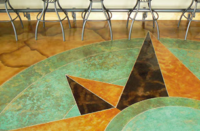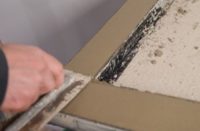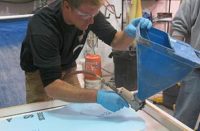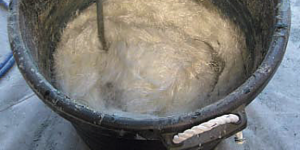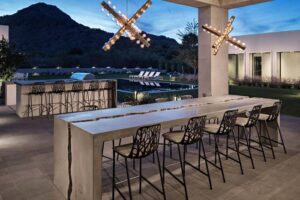One of the allures of crafting sinks and surrounding countertops out of concrete are the material’s chameleon-like characteristics that can mimic everything from natural and polished stone to draped fabric and tiered surfaces. Seen here are an ad hoc collection of sinks made by artisans throughout North America that illustrate some possibilities of concrete’s form and function.
Bringing it home
Integral sink vanities are what drew Tamara Gilgenast of Concrete In-Counters to decorative concrete in the first place. “If we can form it, we can create it,” she says. It’s this formability that she believes sets concrete apart from the likes of granite, marble and soapstone.
Case in point: She created her very first vanity top for a guest bathroom and wanted it to do more than reflect the rustic and cozy guestroom area. “I wanted to create a rugged and beautiful piece,” for her house in Enterprise, Alabama, she says, “that reflected what I love — the Rocky Mountains.”
Based on what she learned about The Ashby System in training out West, Gilgenast chose to create the vanity in two separate pieces to make installation easier. She made the large vanity with the integral sink first and then the riser backsplash which also functions as a shelf.
The two-piece vanity top, which could have been cast as one, is grouted and sealed to ensure easy cleaning as well as no issues with water, soap or toothpaste retention.
The vanity, riser and sink were made with Ashby Admix SR and The Ashby System Marbleizer, and colored with San Diego Buff with custom-mixed vein colors. It has a Broken Flagstone edge.
“This piece is as beautiful today as the day it was installed,” Gilgenast says.
www.councreteincounters.com
A chip off the old block
This rustic sink — designed by Phoebe McEldowney of Haven Interiors and fabricated in 2013 by Mark Price of In Concrete Design for Highline Partners — has made the rounds on Pinterest.
Inspired by a picture McEldowney found of a reclaimed antique French stone fixture from Chateau Domingue out of Houston, Texas, “It’s a blessing and a curse to be tracked down by people who want this sink,” Price says, as most don’t realize the cost and complexity of custom work.
Overall, though, most Pinterest perusers don’t go to all the trouble of locating Price, who lives in Bozeman, Montana. They simply take the photo to a local concrete artisan, as was the case of Dusty Baker of Stone-Crete Artistry in Hurricane Mills, Tennessee, and ask him or her to make it.
“I think every concrete dude in the U.S. has got this pic and recreated it,” says Baker, who also teaches classes at the Concrete Design School in Eureka Springs, Arkansas. “It’s a great example of how to turn a piece from Pinterest into your own interpretation of it.”
And while Price’s professionally taken photo makes the outcome look lavish and well chiseled, the reality is far from the truth. “They are rough,” Price says, adding that “rustification” is the “technical term” he and his buddies use to describe the process that involved the builder whacking the sinks with a hammer. “In the context of the house, which has hand-hewn thresholds, they fit.”
At the other end of the spectrum, Price says, is his prototype of a one-piece pedestal sink with a sleek waterfall leg. With its simple clean lines and finish, that sink is the epitome of smooth.
www.inconcretedesign.com
www.facebook.com/concretecountertopsnashvilletn
A little bit country
 Designed for an old bureau the homeowners were converting into a bathroom vanity, this mini-farmhouse sink built by Warren Stred of Saint Red Design in Boston, Massachusetts, added just the right touch of country flair.
Designed for an old bureau the homeowners were converting into a bathroom vanity, this mini-farmhouse sink built by Warren Stred of Saint Red Design in Boston, Massachusetts, added just the right touch of country flair.
To make it look like an authentic farm sink, the clients went with regular gray portland cement which resulted in a mottled look with different greens and grays. “There’s a lot of movement in the concrete and that’s what they wanted,” Stred says.
 The 14-by-18-inch sink has a basin that slopes from 7 to 9 inches with a hidden drain and a slot that runs around the perimeter of the base. Stred used Buddy Rhodes GFRC blend and sealed it with the Concrete Countertop’s Omega sealer.
The 14-by-18-inch sink has a basin that slopes from 7 to 9 inches with a hidden drain and a slot that runs around the perimeter of the base. Stred used Buddy Rhodes GFRC blend and sealed it with the Concrete Countertop’s Omega sealer.
Stred says he used a very rigid resin to make the mold and he didn’t account for the angles around the curve that goes around the edge. “I had to destroy the mold to get the sink out,” he says. Next time he recreates this sink, he says he’ll use silicone rubber for the mold so maybe he can use it more than once.
www.saintreddesign.com
Made to order
Brett Carragher, owner of Exclusive Concrete in London, Ontario, Canada, says clients approach him with design ideas and he makes them happen. This fabric-formed sink began with a casual sit down in Carragher’s booth at the Market in his town’s Western Fair District, a farmers’ and artisans’ mecca held on weekends where he features one-of-a-kind concrete items.
“They were building a custom addition to their home and wanted a focal point that no one else had for their washroom,” he says. The couple had a vision and he brought it to fruition.
Carragher, who is a product distributor for Buddy Rhodes, used Rhodes GFRC admix and a veining technique he’s been working on for many years. He sealed the black-and-white beauty with Omega countertop sealer from the Concrete Countertop Institute, where back in 2013 Jeff Girard taught him the essential science behind unique concrete countertops.
The other sink pictured here features a two-tiered ramp sink that slopes from right to left on the upper level and then left to right on the lower. The rocks are simply there for decoration in lieu of a metal drain the client thought was too expensive to include.
“My customers’ tastes are very eclectic,” Carragher says.
www.exclusiveconcrete.com
Finessing the stone
This 10-foot-long fabric-formed sink was designed for a client who wanted a show-stopper art piece to dominate his remodeled master bathroom.
And Peter Somers of Concretepoetry Inc. in Hingham, Massachusetts, delivered.
Somers says he wanted to design a sink that transitions very subtly from nothing down to 2 inches deep with an elaborate slot drain that you don’t see.
“The challenge was we had to work with the existing plumbing of the original sinks,” he says. “Which means there’s a drain on either end, not in the middle as it appears.”
The sink is made with a GFRC mix from Buddy Rhodes that covers a form made by stretching fabric over an armature and soaking it with many layers of fiberglass resin until it’s hardened. The coloring is Rhodes’ Carbon Black.
www.concretepoetryboston.com
Over a barrel
Drawing inspiration from the tiered vineyards in Italy and France, Mike Hearn, owner of Artisan Elements in Jasper, Georgia, has made this wine-country sink many times. “The rows go up and down the hills like that,” he says, referring to the inside of the basin, “not in a straight line.”
This one sits in a powder room just off the kitchen in a Craftsman-style home that has a dedicated wine/coffee area. It’s made with one-third of a wine barrel — he’s also made corner versions with a whole barrel — and a sprayed-face GFRC back. The finish is cream with multiple slurry levels sanded to give it a rustic appearance.
Hearn, whose claim to fame is his all-concrete Fred Flintstone car he raced in the Epic derby sponsored by Buddy Rhodes and Blue Concrete back in 2105, used Rhodes’ pigments and water reducer with his own GFRC design mix to make the sink. He sealed it with CCI’s Omega sealer.
For the forms, “I use rigid plastic sheets to make the inside rings,” he says, which he can save and use again. The sink’s larger outer ring is made from flexible foam for a one-time use.
“I enjoy making these sinks,” Hearn says, as each one looks different although the elements remain the same. “They’ve gotten a lot of attention.”
www.artisanelementsllc.com
Beachcombers’ delight
When Annette Davis of Artistic Impressions LLC in Luana, Iowa, accepts a design job she first sits down and talks to her clients about their interests. This particular one had a shell collection from family trips over the years and they wanted to incorporate them into one of their new bathrooms.
At first, Davis thought about casting them into the concrete but then the family wouldn’t be able to see them all. So she surfed through Pinterest to get ideas and landed on a design she could modify.
Putting the shells under a piece of Plexiglas was an easy way to display them. She could also dot the sink basins with pieces of glass reminiscent of sea glass that washes up on beaches. And she could accent the concrete sinks surrounded by a sea of shells with actual fish fossil inlays, also contributed by the family.
If the family ever wants to switch out the shells, all they have to do is unscrew the sinks and lift the glass. The 45-pound sinks are weighty enough to keep the thick Plexiglas securely in place without an adhesive.
Davis used Buddy Rhodes GFRC mix to cast the sinks she made with reusable fiberglass forms from Expressions Ltd. She sealed the sinks with Omega sealer from the Concrete Countertop Institute, where she hails as an alumna.
Classy sinks
At the Concrete Design School in Eureka Springs, Arkansas, students in the Fabric-Forming Concrete Sink + GFRC Workshop come up with a design, fabricate the mold, cast the sink, demold it, and then finish and seal the concrete.
“Students come in on the first morning to a blank slate. An idea for a sink doesn’t even exist,” says instructor Brandon Gore, who is also the proprietor of Gore Design Co. and Hard Goods. “And by the end of the second day, we have a sink ready to ship.”
The class works as a group, problem solving glitches as they pop up. Rather than using someone else’s prepackaged mix, they learn to blend their own — an ultra high-performance GFRC mix design.
Gore, who began teaching his fabric-forming technique in 2008, says the process has been refined and continues to evolve every year. “What we teach today is vastly different from what we taught even a couple of years ago,” he says. “We’re always improving, making the technique more precise and easier.”
The class is offered four times a year at the specially built training facility in the Ozark Mountains of northwest Arkansas.
www.concretedesignschool.com
Crop circle sighting reported
Glowing GFRC makes this 9-foot-long bathroom vanity in a home in Toronto, Ontario, Canada, stand out in more ways than one.
For starters, it makes an interesting design element where form meets function, says Peter Tomé, president of Ambient Glow Technology and the vanity fabricator. The concrete countertop, integrally colored with AGT Sky Blue Fine Glow Sand, also serves as a passive light source at night. It allows the homeowners to visit the washroom in the middle of the night without having to turn on the lights.
The homeowners requested the vanity include a “crop circle” design because of their fascination with sacred geometry and other land-based geometric phenomena. Tomé engraved the shapes, powered by AGT Aqua Blue Fine Glow Sand, with an Engrave-A-Crete Wasp.
“Engraving the geometric shapes required a steady hand to keep the lines sharp,” Tomé says. “Essentially it was like tattooing concrete.”
The vanity also features silver-dipped ½-inch tumbled glass from Heritage Glass. To keep it in place at the bottom of the concrete form when the GFRC face coat was sprayed, water-based woodworker’s glue was lightly rolled onto the form’s surface and then the glass was hand-seeded.
Once cured, the vanity was diamond polished.
www.ambientglowtechnology.com
Purposeful ridges
What began as a job to make two adze-textured concrete door panels for a custom lakeside home in Whistler, British Columbia, Canada, ballooned into casting the adze texture into rubber and carrying the theme throughout the house.
As part of the expanded project, Ian Wyndlow of Liquid Stone Studios in Ladysmith, British Columbia, says he was given carte blanche to design a one-of-a-kind bathroom vanity with an integral sink.
 “Inspired by the reflection of the steep cliffs and deep valleys of the surroundings in the lake, we took the idea of terracing the contours and ran the lines vertically, as though to produce a deep fjord,” he says.
“Inspired by the reflection of the steep cliffs and deep valleys of the surroundings in the lake, we took the idea of terracing the contours and ran the lines vertically, as though to produce a deep fjord,” he says.
The GFRC sink was made with a Buddy Rhodes admixture with 8 percent titanium white color loading. It was sealed with Rhodes’ PS-1 Reactive Sealer.
Wyndlow was also given a free hand to design another bathroom vanity for a custom home in Nanaimo, British Columbia, that was a conventional wet cast pour. The challenge was the local building code dictated it had an overflow.
“I wanted the design to include ramp sinks and slot drains and decided that instead of the complicated set-up to fabricate separate overflows with the slot drains, I would simply join the two sinks with a ‘moat’ so that if one happened to plug and the water left on, the other sink would act as the overflow.”
The sinks were also equipped with integral soap holders that sloped to allow excess water to drain and had a ridge to prevent the bar from sliding into the sink.
www.liquidstonestudios.com
Surprise and functionality
If you want to grab attention design-wise, Ben Ashby of StoneCrete Systems in Farr West, Utah, recommends incorporating something unexpected, such as water or fire.
One of Ashby’s recent advanced classes in Las Vegas centered on creating a sink that featured water cascading toward you and then disappearing. “Humans are drawn to moving water,” he says. “The more movement, the more it draws you in.”
 The class combined concrete made with Ashby Admix SR with stacked slate to make the water move and fall. In less than a week’s time, the sink went from concept to a working unit in his facility’s washroom.
The class combined concrete made with Ashby Admix SR with stacked slate to make the water move and fall. In less than a week’s time, the sink went from concept to a working unit in his facility’s washroom.
Ashby says the industry-specific products, like admix and sealer, are available from his website while everything else was purchased at a big box store because he likes to keep things simple to keep costs down.
Simple but functional, this countertop and integral sink are “all about functionality.”
Designed for a man who entertained extensively, the flat-bottomed sink is just the right depth for long-neck beers to poke out above a sink full of ice and wide enough to hold beer cans sideways. “The sink is actually a beer cooler with a drain,” Ashby says. On the decorative side, its basin is faux finished to look like a tarnished copper sink.
For the finishing touch, the client chose a pot filler-style faucet. “He lines the counter with crockpots and trays of food like he’s tailgating in his basement,” Ashby says. “The faucet can be tucked away, clearing up counterspace. It’s really very functional,” besides looking cool.
Ashby sealed the sink/cooler with his UV sealer, a solvent-based polyurethane that’s normally used outdoors. “It’s a great sealer for wet locations,” he says.
www.stonecretesystems.com
